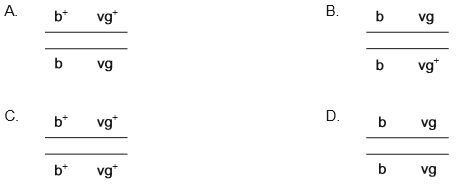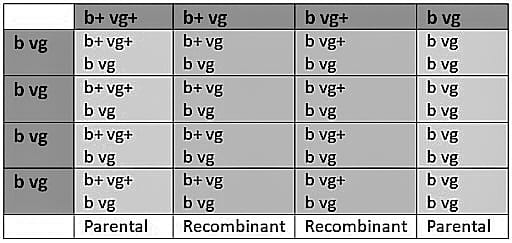IB Biology HL (HIGHER level)- 2024 – Practice Questions- All Topics
Topic 10.2 Inheritance
Topic 10 Weightage : 10%
All Questions for Topic 10.2 – Dihybrid Crosses, Linked Genes, Recombinants, Chi Squared Test, Chi Squared Table, Polygenic Traits, Test Cross, Centimorgan
Question
In fruit flies (Drosophila melanogaster), grey bodies (b+) are dominant to black bodies (b) and normal wings (vg+) are dominant to vestigial wings (vg). Homozygous vestigial winged, black bodied flies were crossed with individuals that were heterozygous for both traits.
2300 individuals were counted and the phenotypes observed were recorded as shown.
965 normal wings, grey bodies
944 vestigial wings, black bodies
206 vestigial wings, grey bodies
185 normal wings, black bodies
Which statement is valid?
A The predicted phenotypic ratio was 9 : 3 : 3 : 1.
B There is independent assortment of wings but not body colour.
C The expected number of vestigial winged, grey bodied flies was 575.
D The traits are on different chromosomes.
▶️Answer/Explanation
Ans: C
The correct answer is C. The expected number of vestigial winged, grey bodied flies was 575. This can be calculated using a Punnett square or by using the formula: (total number of offspring / 16) x 3. The total number of offspring is 2300, so (2300 / 16) x 3 = 575.625. This means that the expected number of vestigial winged, grey bodied flies is approximately 575. The predicted phenotypic ratio was not 9 : 3 : 3 : 1 (option A), as this is the expected ratio for a dihybrid cross with independent assortment. In this case, the ratio is not 9 : 3 : 3 : 1 because the traits are not assorting independently. There is linkage between the traits, so option B is also incorrect. The traits are on different chromosomes (option D) is not valid, as they are on the same chromosome, but they are not assorting independently due to linkage.
In a plant, dark leaves are dominant to pale leaves and yellow seeds are dominant to white seeds.
A heterozygous dark-leaved plant with yellow seeds was crossed with a pale-leaved plant with white seeds. A large number of offspring were produced. They were either dark-leaved with yellow seeds or pale-leaved with white seeds in equal number.
What is the most likely cause of this pattern?
A. Crossing over has occurred.
B. The two genes are linked.
C. The traits are polygenic.
D. The genes are codominant.
▶️Answer/Explanation
Markscheme
B
The correct answer is B. The two genes are linked. The fact that the offspring are either dark-leaved with yellow seeds or pale-leaved with white seeds in equal numbers suggests that the two traits are inherited together, which is consistent with the idea of linkage. Crossing over (option A) can disrupt linkage, but this is less likely to be the cause of the observed pattern. The traits are not polygenic (option C), as they are controlled by single genes. The genes are not codominant (option D), as the dominance relationships are given as dark leaves being dominant to pale leaves and yellow seeds being dominant to white seeds.
The genetic determination of dogs’ coats can be quite complex, with many different genes acting at the same time.
• The dominant allele E gives brown tones. The recessive allele e results in red tones.
• The colour intensity is due to another gene. The dominant allele B gives a dark colour, whereas the recessive allele b results in a light colour.
What would be the genotype of a light brown dog produced from a cross between a dark brown dog and a light red dog?
A. EEbb
B. EeBb
C. eeBb
D. Eebb
▶️Answer/Explanation
Markscheme
D
The correct answer is D. Eebb. This is a simple two-factor cross, so we can use a Punnett square to determine the possible genotypes of the offspring. The dark brown dog is most likely homozygous for the dominant brown allele (EE), and the light red dog is most likely homozygous for the recessive red allele (ee). Therefore, the cross is EEBB x eebb. The F1 generation will all be heterozygous for both genes (EeBb). When two EeBb dogs are crossed, there are four possible genotypes for the offspring: EEBB, EEbb, EeBB, and EeBb. The light brown dog must have at least one copy of the recessive b allele, so it cannot be EEBB or EeBB. It must have at least one copy of the recessive e allele, so it cannot be EEBb or EeBB. Therefore, the only possible genotype for a light brown dog is Eebb.
Some of the ratios that Morgan investigated in genetic crosses did not correspond with expected Mendelian ratios. What was the cause?
A. The genetic crosses used insects rather than plants.
B. The results were counted more reliably than Mendel’s.
C. The genes in the genetic crosses were linked.
D. Drosophila has more genes than plants.
▶️Answer/Explanation
Markscheme
C
The correct answer is C. The genes in the genetic crosses were linked. Morgan’s work with fruit flies (Drosophila) led him to discover that some genes are linked and do not assort independently as Mendel’s law of independent assortment would predict. This is because linked genes are located close to each other on the same chromosome and tend to be inherited together, rather than being sorted independently during meiosis. This discovery led to the development of the concept of genetic linkage and paved the way for the discovery of chromosomal mapping and the physical basis of inheritance. Options A, B, and D are not related to the cause of the unexpected ratios observed by Morgan.
This is the cross that led to the discovery of non-Mendelian ratios in Morgan’s experiments with Drosophila.

Which is a recombinant genotype?

▶️Answer/Explanation
Markscheme
B
b+ b vg+ vg × b vg

Hence, the correct option is B
The statement is about the genetic control of cat coat colour.

In a cross between two double heterozygous tabby cats, what would the expected proportion of black offspring be?
A. 1 out of 16
B. 3 out of 16
C. 4 out of 16
D. 9 out of 16
▶️Answer/Explanation
Markscheme
C
– The dominant allele M codes for straight stripes, whereas the recessive allele m codes for blotches and whorls instead of stripes.
– The dominant allele A produces two-toned hair, to reveal coat patterns, whereas the recessive allele a causes all coat hair to be black and so hides any pattern.
MmAa × MmAa
Thus, the correct option is C.
Question
Black, short-haired guinea pigs, heterozygous for both characteristics, were crossed. They produced offspring with the phenotypes black short-haired, black long-haired, white short-haired and white long-haired in the ratio 9:3:3:1. A different cross produced offspring with phenotypes in the ratio $1: 1: 1: 1$. What were the genotypes of the parents in the second cross?
A. $\mathrm{BbSs} \times \mathrm{BbSs}$
B. $\mathrm{BBSs} \times \mathrm{BbSS}$
C. $\mathrm{BbSs} \times$ bbss
D. $\mathrm{bbSS} \times \mathrm{BBsS}$
▶️Answer/Explanation
Ans:C
BbSs × BbSs

Phenotypic ratio: 9:3:3:1
BbSs × bbss

Thus, the correct option is C.
Phenotypic ratio: 1:1:1:1
